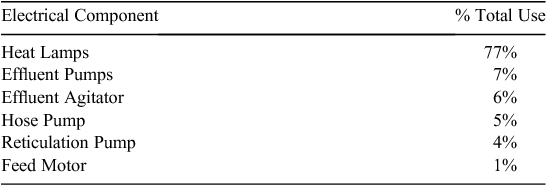Breakdown of electrical energy use during summer and winter at six piggeries
E. J. McGahan A , B. R. Warren A B and R. J. Davis AA FSA Consulting, Toowoomba, QLD 4350.
B Corresponding author. Email: bradley.warren@fsaconsulting.net
Animal Production Science 55(12) 1463-1463 https://doi.org/10.1071/ANv55n12Ab104
Published: 11 November 2015
Energy efficiency is an important performance and sustainability indicator for the Australian pig industry because of the rise in energy costs and increased focus on greenhouse gas emissions. Wiedemann et al. (2012) showed a seven-fold variation in electricity usage across naturally-ventilated, farrow to finish piggery unit types, suggesting opportunities for improved energy efficiency. A survey of 21 piggeries showed on that on average the highest energy use component is electricity at 75% (McGahan et al. 2014). The aim of this study was to continuously monitor electricity use for a 2-week period in summer and winter at six piggeries, five in Queensland and one in Victoria.
The piggeries included natural and tunnel-ventilated sheds, farrow to finish, finisher and breeder units. Electricity was monitored by current transformers attached to electrical circuits and measured by a Nemo® 72-L power meter and an Environdata® data logger. An Environdata® temperature probe logged ambient temperature. The system was capable of measuring electricity from three circuits simultaneously, allowing high energy use areas to be identified.
Monitoring showed that electrical energy usage is heavily dependent upon ventilation system type and climatic conditions (Table 1). Naturally ventilated farms all used less electricity during summer compared to winter, possibly due to a decrease in operating hours for the farrowing heating system. Electrical energy use at tunnel ventilated farms increased during summer, probably due to warmer temperatures increasing the operating time of the ventilation fans. In naturally ventilated piggeries containing farrowing, the highest electrical consumption was from heat lamps (Tables 2 and 3). These piggeries could improve energy efficiency by reducing the heating area and heat wastage, or by installing a thermostat to automatically switch off heat lamps when the temperature reaches a trigger level. Electrical energy usage in tunnel-ventilated piggeries is driven by the use of ventilation fans to maintain shed climate. These piggeries can improve energy efficiency by ensuring the control system is operating correctly and fans are well maintained. Other ways to improve electrical energy use includes, selecting energy efficient lighting types (compact fluorescent or LED), and ensuring that motors and pumps are correctly sized and well maintained. Energy costs can be reduced through managing and reducing peak energy loads. If possible, peak energy use should be converted to low tariff hours.

|

|

|
References
McGahan EJ, Warren BR, Davis RJ (2014) Australian Pork Limited Report Project No. 2012/2407.Wiedemann SR, McGahan EJ, Murphy C (2012) Pork CRC Limited Australia Report Project No. 4C/101.
This project was funded by Australian Pork Limited.


